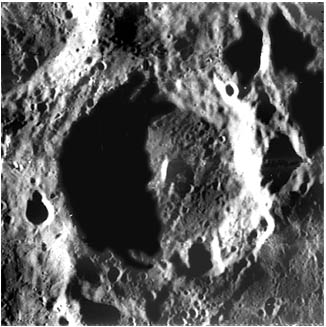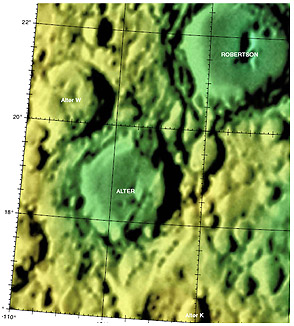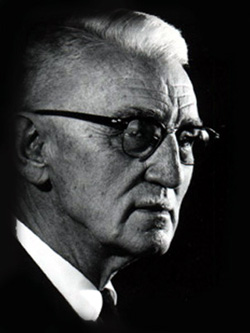Alter
Contents
Alter
| Lat: 18.7°N, Long: 107.5°W, Diam: 64 km, Depth: km, Rükl: (farside) |


USGS Digital Atlas PDF: (left image)LO - LAC 54, (right)Color-Coded - LAC 54
Just east of Alter's central peak (running from south to north-east direction across the crater's floor) is a cleft that appears on close-up to be made from a series of smaller impact craters (a catena?). Is the source of this suggested catena that of secondaries from Robertson in the north-east - classified as Copernican in age (1.1 bn years - present)? The area is also covered in ejecta from Mare Orientale, which lies over a thousand kilometres away from Alter in the south-east direction.
Images
LPOD Photo Gallery Lunar Orbiter Images
Maps
(LAC zone 54D4) USGS Digital Atlas PDF
Description
Description: Wikipedia
Additional Information
Possible catena (craterchain) immediately east of Alter's central peak? (see description below the images above).
Nomenclature
- Named for Dinsmore Alter (March 28, 1888 – September 20, 1968), an American astronomer and meteorologist, for many years a professor at the University of Kansas, and after that, Director of the Griffith Observatory in Los Angeles. He was the author of two influential photographic guides to the Moon. His early studies had focused on solar observation, but he became increasingly concentrated on the Moon. As his expertise increased, he became an authority on the geology of the Moon, including its surface and history. In 1956 he used the 60" reflector at the Mount Wilson Observatory to observe a peculiar obscuration on part of the floor of Alphonsus crater, which brought him worldwide notice. This is a class of events now called a transient lunar phenomenon.

Photo of Dinsmore Alter - courtesy of the International Planetarium Society (IPS) and The Planetarian - Journal of the IPS. - Not to be confused with Alder.
- In the days of Hugh Percy Wilkins the nearside crater Albategnius G was temporarily known as Alter. Alas, the IAU decided to give the name Alter to a farside crater (officially recognized).
LPOD Articles
Bibliography
- North American Aviation, inc, and Dinsmore Alter. 1964. Lunar atlas. Los Angeles, Calif.: North American Aviation.
- Alter, Dinsmore. 1963. Pictorial guide to the moon. New York: Thomas Y. Crowell Company.
Dinsmore Alter in the Sourcebook Project (William R. Corliss)
- In Mysterious Universe, a handbook of astronomical anomalies (1979) :
- Page 32: A Critical Test of the Planetary Hypothesis of Sun Spots (Monthly Weather Review, 1929)
- Page 447: Four Independent Drawings of Ganymede (Walter H. Haas, Sky and Telescope, 1950)